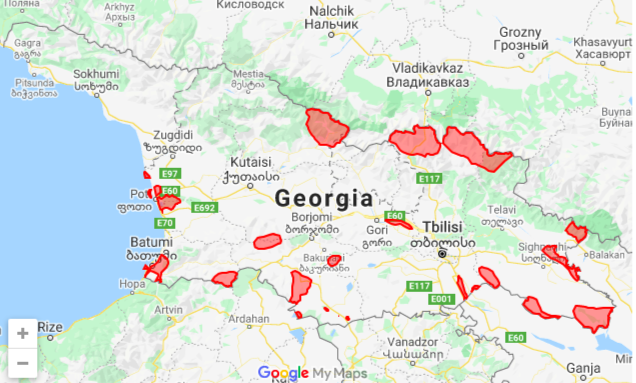Taxonomy
Kingdom Animalia (16266)Phylum Chordata (708)
Class Amphibia (14)
Order Caudata (6)
Family Salamandridae (6)
Genus Ommatotriton (1)
Species Ommatotriton ophryticus
Browse by taxonomy
Simple search by name
Ommatotriton ophryticus ✓
Northern banded newt, მცირეაზიური ტრიტონი
Name According To: https://amphibiaweb.org/; www.biodiversity-georgia.net
Species: ophryticus
Taxon Rank: Species
Scientific Name Authorship: Berthold, 1846
Vernacular Name: Northern banded newt
Georgian Name: მცირეაზიური ტრიტონი
GBD Remarks:
Ommatotriton is a distinct taxon with a limited Asia Minor and Caucasian distribution. Recent genetic data suggest that it does not build a monophyletic group with other newts formerly included in the genus Triturus. Outgroup of Ommatotriton is a wide-spread W Palaearctic group Triturus cristatus-T.marmoratus (genus Triturus s.str), separated from Ommatotriton over 10 MYBP (Zajc & Arntzen, 1999). Ommatotriton comprises of two species - O. vittatus from the Middle East and O. ophryticus from the western half of the Caucasus Isthmus and southern coast of the Black Sea.
The species is common in Georgia. It inhabits mountain forest belt and alpine grasslands close to the upper timberline. Any kind of stagnant and slowly running waters. Breeding in April-June, some males stay in water throughout the year. Female deposits up to several hundreds of eggs wrapping them in live or fallen grasses and water plants. Male crest is higher than in any other newts.
Page Authors: David Tarkhnishvili ,
Reference of occurrence in Georgia: D. Tarkhnishvili & R. Gokhelashvili, 1999. The Amphibians of the Caucasus. Pensoft, Sofia.
Georgian biodiversity database contains 34 occurrences of Ommatotriton ophryticus
| Occurrence ID | Basis of Record | Locality | Recorded By | Decimal Latitude | Decimal Longitude |
| 6643 | Goderdzi | 41.642 | 42.563 | ||
| 6644 | Goderdzi Subalp 3d | 41.634 | 42.554 | ||
| 6645 | Charnali 1 | 41.556 | 41.611 | ||
| 6646 | Aider1 | 40.933 | 41.142 | ||
| 6647 | Chiantba | 41.918 | 45.370 | ||
| 6648 | Jvari | 41.839 | 44.740 | ||
| 6649 | Chilitba | 41.812 | 44.678 | ||
| 6650 | Tskhneti | 41.686 | 44.673 | ||
| 6651 | Samadlo | 41.672 | 44.637 | ||
| 6652 | Tsodoreti | 41.766 | 44.630 | ||
| 6653 | Satovle2 | 41.795 | 44.592 | ||
| 6654 | Satovle1 | 41.790 | 44.580 | ||
| 6655 | Lelobi | 41.786 | 44.564 | ||
| 6656 | Gudauri | 42.463 | 44.488 | ||
| 6657 | DIDGORI | 41.726 | 44.457 | ||
| 6658 | Ertatsminda | 41.842 | 44.304 | ||
| 6659 | Pitsesi | 41.864 | 44.228 | ||
| 6660 | Nedzvi2 | 41.876 | 43.525 | ||
| 6661 | Iagoras-veli | 41.752 | 43.518 | ||
| 6662 | Nedzvi1 | 41.889 | 43.516 | ||
| 6663 | Kakhisi3 | 41.766 | 43.356 | ||
| 6664 | Kakhisi1 | 41.774 | 43.351 | ||
| 6665 | Kakhisi2 | 41.766 | 43.349 | ||
| 6666 | Kakhisi4 | 41.756 | 43.344 | ||
| 6667 | Erusheti6 | 41.633 | 42.712 | ||
| 6668 | Erusheti5 | 41.632 | 42.694 | ||
| 6669 | Erisheti1 | 41.640 | 42.674 | ||
| 6670 | Erusheti3 | 41.614 | 42.648 | ||
| 6671 | Erusheti2 | 41.614 | 42.629 | ||
| 6672 | Erusheti4 | 41.622 | 42.626 | ||
| 6673 | Karagol | 41.384 | 41.855 | ||
| 6674 | mtsvane kontskhi | 41.707 | 41.723 | ||
| 6675 | Charnali | 41.557 | 41.610 | ||
| 7019 | Kvemo Kartli, Georgia | 41.777801 | 44.104248 |
Information from GBIF about Ommatotriton ophryticus
GBIF scientific name: Ommatotriton ophryticus (Berthold, 1846)
GBIF taxonomic status: ACCEPTED

Conservation Status
This section is under construction
National Red List Status: NT
IUCN Red List Status: NT
Protection status: Not defined
Reason: N/A
Trend: Declining
EOO: >20000
AOO: >2000
Native/Introduced: Native
Comment: სტატუსი NT. მართალია, სახეობა სრულად არ აკმაყოფილებს არცერთ კრიტერიუმს რომლის საფუძველზე ის შეიძლება ჩაითვალოს მოწყვლადად, მისი არეალი (1) ფრაგმენტირებულია, (2) მისი ბუნებრივი გამრავლების ადგილები, პატარა ზომის ტბები და ტბორები, განიცდიან ზეწოლას ანტროპოგენული ამოშრობის და თევზის (კარჩხანას) ექსპანსიის გამო.
Georgian Name: მცირეაზიური ტრიტონი
English Name: Northern banded newt
Synonyms: Triturus vittatus ophryticus, Ommatotriton vittatus ophryticus
Taxonomy according to: https://amphibiaweb.org/; www.biodiversity-georgia.net
References: Bannikov et al., 1977; Tarkhnishvili, 1996; Tarkhnishvili et al 2002; Litvinchuk, 2017
Evaluated By: Tarkhnishvili D., Iankoshvili G.
Date evaluated: Nov 2021




